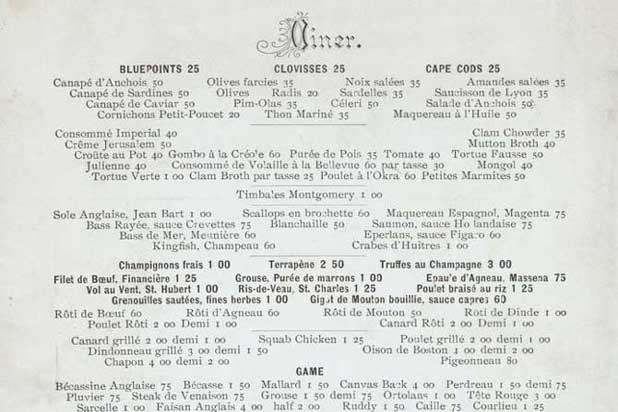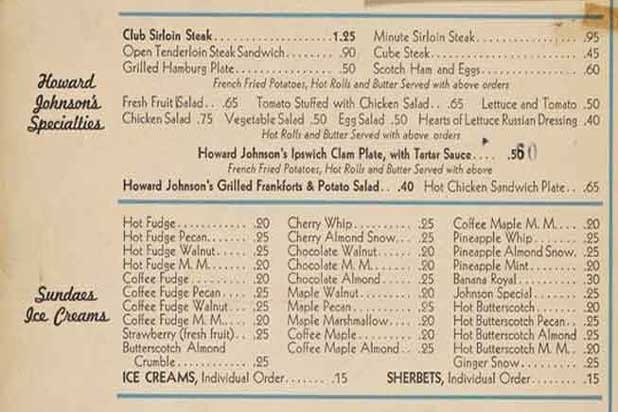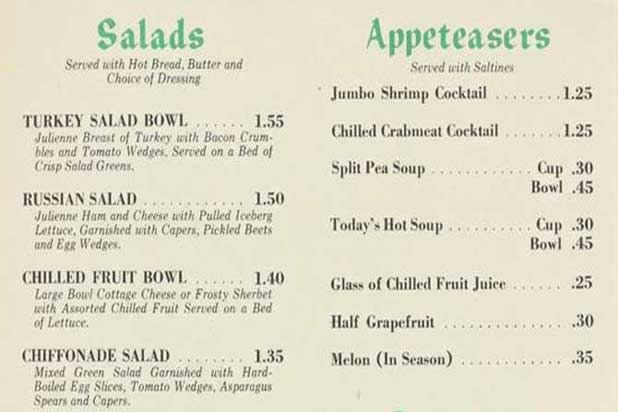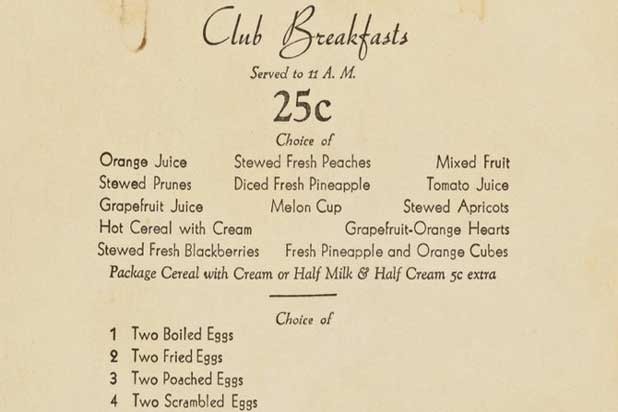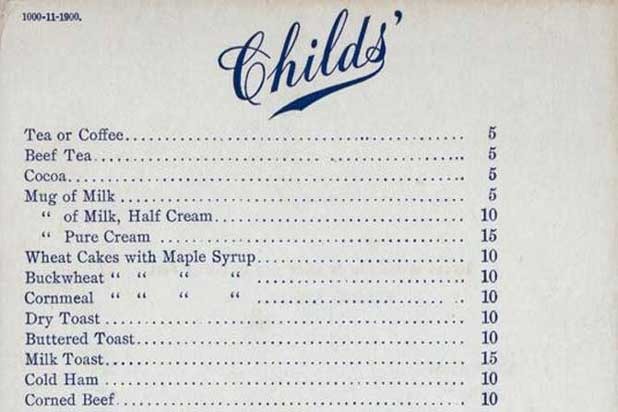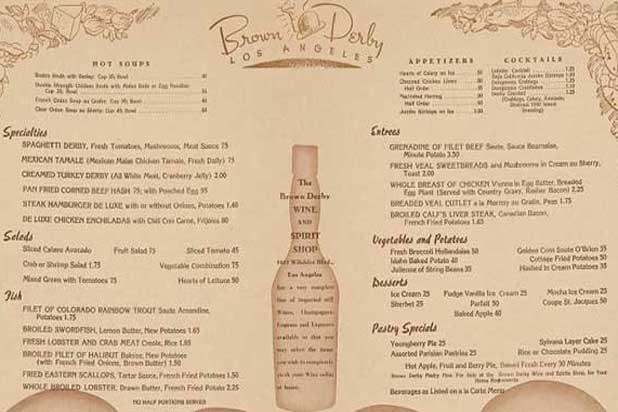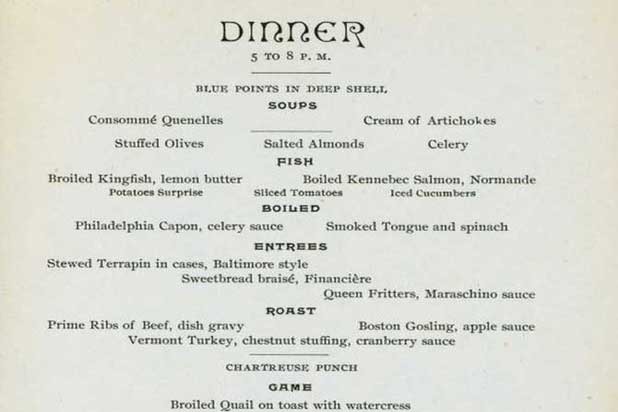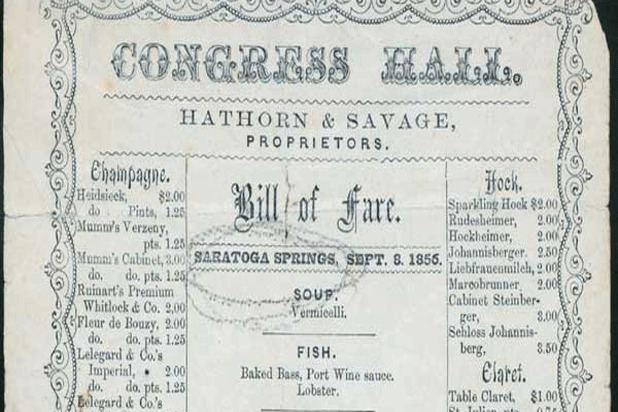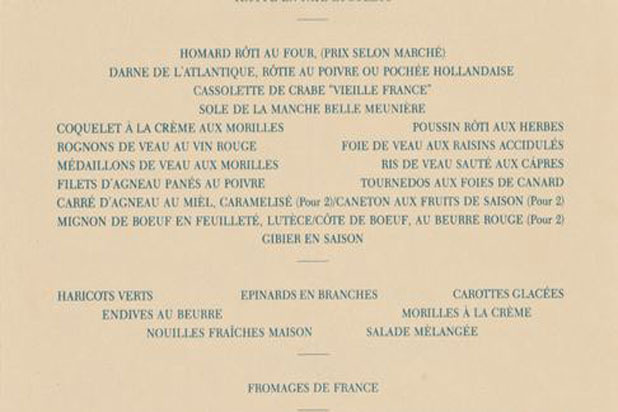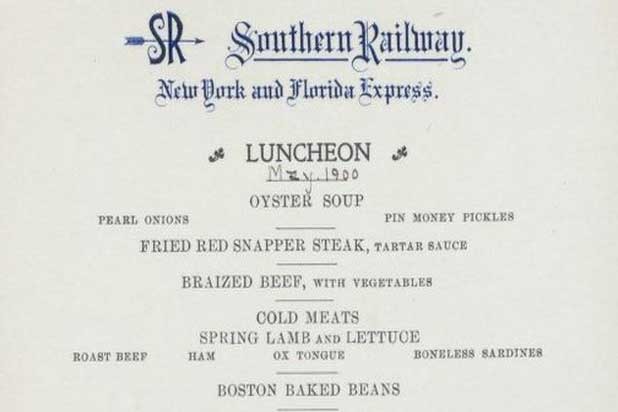Menu Of The Week Slideshow
When you first take a look at this 1897 menu, the bill of fare from the Waldorf-Astoria, arguably the finest hotel in New York at the time, the first thing that jumps out is the fact that it's all in French.Even the little note telling guests that they can prepare a pre-theater menu is in French, and the one above it saying that they don't accept reservations after 7 p.m.
While this menu might look completely different from ones you'll see today, it's not very different from how it was at fine dining establishments throughout the country at this time. Fine dining wasFrench dining; they were essentially synonymous. The menu is divided into soups, salads, seafood, a highlighted section where all the most expensive stuff was listed (things haven't changed much after all), meats, game, vegetables in various preparations, cheeses, fruits, and lots of desserts.
Howard Johnson’s, 1950s
This week's menu dates from HoJo's 1950s heyday, and provides a great snapshot of what the Space Age American palate was like back then.
Steak, "grilled Frankforts," and ice cream were highlighted items, and top sellers (the fried clam plate, also in bold, was actually a major innovation for the restaurant; before HoJo's, fried clams were "whole belly" clams, and the chain took to frying the more palatable "clam strips," which then grew in popularity in a major way).
Sandwiches were also a major part of the menu, and came in some pretty funky varieties. You don't often see a chop suey roll, cream cheese and olive, sardine, or "Western" sandwich any more, if ever, and a sandwich with just lettuce and mayonnaise on it seems pretty darn skimpy these days. It's a bit surprising that there's a peanut butter and bacon sandwich on the menu as well, as that's more the domain of funky food trucks these days. Triple-decker club sandwiches are still available at just about any diner, as is the dinner combo of half a chicken with accompaniments like potatoes, vegetables, salad, rolls, and butter.
Holiday Inn, 1969
This menu from July 1969 (Woodstock!) gives you a great snapshot of how people were eating back then: in a word, simply.
The menu begins with a selection of salads (including the Russian Salad, with ham, an unnamed cheese, iceberg lettuce, capers, pickled beets, and egg wedges), "Appeteasers" like shrimp cocktail and soup, and desserts like hot apple pie with a cheddar cheese crust, which was most likely delicious.
Not sure why the entrée page is titled "John Holiday Specials," or why the chicken section has a long description of how man domesticated the fowl (to be funny, most likely), but the entrees are pretty straightforward: spaghetti with meat sauce, steaks, fried or broiled chicken, pork chops, hot sandwiches, liver, and a hilarious "Low Calorie Special" a nod to the health craze that was in its infancy then: a broiled beef burger, cottage cheese with a peach or pair, and a "cracker basket." How times have changed!
On the last page is a selection of fried and broiled seafood, as well as some cold sandwiches, including the classic triple decker club.
Breakfast at Horn & Hardart, 1940
The most defining aspect of the automat was convenience, and lots of folks would drop in for a quick breakfast on their way to work. Inthis breakfast menu from 1940 (courtesy of the New York Public Library), when the automat was at its height of popularity, a wide selection of breakfast items are on display. Just $0.25 would get you fresh or stewed fruit or juice and eggs, griddle cakes, or "frizzled beef" (which is another name for chipped beef) on toast.
There was also a nice selection of breakfast cakes and breads, like coffee cake, cinnamon buns, and the great-sounding "cinnamon butterfly cake" which contains raisins and pecans. There are also plenty of cereals (including the long-gone Wheatsworth), and hot breakfasts like omelettes, country-style tongue and egg, fried tomatoes with scrambled eggs, and the intriguing "pancake-style" deviled ham and egg.
Childs, 1900
This menu from the New York Public Library's online archive dates from 1900, just two years after aggressive expansion plans were put into place, and is a great snapshot of what businessmen ate for breakfast and on their lunch breaks at the turn of the century. It's a very simple, elegantly arranged menu, with many dishes that wouldn't be out of place on a menu today. A few interesting items jump out, though: at first we weren't sure what "beef tea" was, but it turns out that it was a very popular drink back then and is just beef broth. The pancakes certainly sound good as well (they were famously cooked to order in the front windows), as do the soups, stews, and hash. We're intrigued by the "cornstarch," however; that doesn't sound too appetizing on its own, and the minced tongue sandwich most likely wouldn't go over so well today. There are still a couple of (mostly Chinese) restaurants that serve oyster omelettes, but you probably won't be seeing milk toast, a majorly vintage dish in which toast is dunked into hot, salted, thickened milk, on menus anymore.
Brown Derby, 1948
This is a pretty classy menu, surprisingly high-end but still full of universal classics. In short, though, the offerings here are really all over the map. Appetizers range from matzo ball soup to chopped chicken livers to lobster cocktail to the Derby Cocktail, which came with crab legs, celery, avocado, and strained Thousand Island dressing. Entrées include spaghetti with tomatoes, mushrooms, and meat sauce, corned beef hash, chicken enchiladas, "grenadine of filet beef" with béarnaise sauce, braised short ribs, fresh veal sweetbreads, a hamburger, trout amandine, and a whole broiled lobster. Desserts included cakes, pies, ice creams, and "Coupe St. Jacques," sliced fruits topped with ice cream or sherbet.
Head to the back page of the menu, and you'll find salads and "From the Broiler" options. Salads include the Derby Salad (which includes something you don't often see nowadays, julienne of tongue), as well as the famous Cobb Salad, and broiled options include a nice selection of steaks along with broiled mushrooms with bacon on toast.
If a modern restaurant consultant were to take a look at this menu, they'd most likely tell the owner to focus it a bit more. But part of what made the Brown Derby so popular was its democratic approach to dining: if you just wanted a quick bowl of soup or a burger, so be it. But if you happened to be Clark Gable discussing a contract and in the mood for a lobster, they'd set you up with one of those as well.
Thanksgiving at New York City’s Broadway Central Hotel, 1899
The 400-room Broadway Central Hotel was built in 1870, and at the time it was the largest hotel in the world. Located on the west side of Broadway between Bleecker and Third Street, which was then called Amity Street, it was in the heart of the city's entertainment district and boasted the finest luxuries of the day, including three grand dining rooms and top-of-the-line furnishings. With its mansard roof and ornate lobby, it certainly looked the part as well.
While it wasn't the largest hotel in the world any more by the time Thanksgiving 1899 rolled around, it was still a swanky neighborhood and the hotel still catered to the elite. The menu for the evening, which we found in the New York Public Library's online archive, was separated into Soups, Fish, Boiled, Entrées, Roast, Game, Salads, Cold Meats, Vegetables, and Desserts sections, and it's clear that this must have been quite a feast.
Saratoga Springs’ Congress Hall, 1856
Congress Hall, with its sturdy mansard roof and stately arcade, was one of those hotels that catered to well-heeled visitors who were "taking the cure" at Saratoga. On Sept. 8, 1856, the bill of fare (which we tracked down via the New York Public Library'sarchive) featured a smallish but ornate assortment of what must have been the finest cuisine of the day; a good example of what the hoi polloi was eating in the years leading up to the Civil War. There was vermicelli soup to start, and baked bass with a port wine sauce lobster in the seafood department. Lots of old menus have a "boiled" section, even though that sounds rather unappealing today, and this one included leg of mutton, ham, corned beef, or chickens (love the fact that chickens is plural). Cold dishes included glazed Westphalia ham or tongue, and there was roast mutton, beef, veal, lamb, or stuffed spring chickens (again with the plural chickens).
Lutèce, 1980
The menu is separated into nine sections: soups; a variety of mousses and appetizers; seafood including sautéed lobster and a whole salmon or bass en croute (in a pastry crust); "Truffe en Pate Lucullus;" entrées including crab cassolette, the classic sole meuniere, cote de boeuf, and several preparations of veal, lamb, chicken, and duck (including the popular braised lamb with garlic); sides including glazed carrots, green beans, endives in butter, and morel mushrooms; French cheeses, and desserts including chocolate mousse with rum, flambéed crepes, chocolate-orange cake, and soufflés; and finally coffee and tea.
Andre Soltner was one of the first chefs in America to emphasize fresh, seasonal ingredients (the morels indicate that this was a spring menu), and he incorporated rustic dishes of his native Alsace into the menu and nightly specials, like an onion tart, which became one of the restaurant's most famed dishes. And while the menu might indicate that Lutèce was stuffy and pretentious, the presence of Soltner and his wife Simone, who ran the dining room, gave the restaurant a homey, mom and pop feel (in fact, the couple lived upstairs).
The New York and Florida Express, 1900
The luncheon menu in May of that year, from the New York Public Library's archive, was a fairly simple one, but it still out-did today's Amtrak offerings by a mile. On offer were oyster soup, pearl onions, and "pin money pickles," which were kicked up with some ginger and cinnamon, fried red snapper with tartar sauce, and "braized" beef with vegetables. Cold meats included spring lamb, roast beef, ham, ox tongue, and sardines, and lighter fare included baked beans and chicken salad. Boiled potatoes or onions, rice, and string beans were offered on the side. Cheese and crackers were also offered, as were apple pie, assorted cakes, wafers, and "Golden Gate fruit," which I haven't been able to track down any details about. Beverages included coffee, milk, tea, and "table water from Wolf Trap Lithia Springs" in Virginia (mentioning that was a nice touch).
Meals cost one dollar, which is the equivalent of about $30 in today's money.
